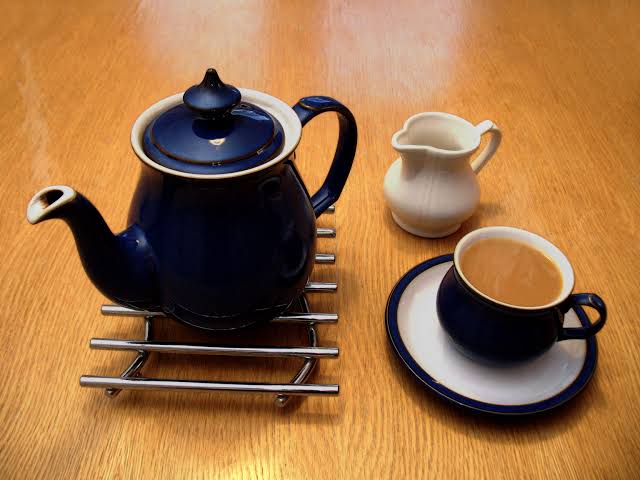A page on tea varieties(green, white, black, oolong or pu-erh), history and their health benefits
The tradition of drinking tea to maintain good health goes a long way back. In early Buddhist texts and Chinese manuals on healing herbs, Camellia sinensis (the tea plant) is consistently described as being a potent medicine for promoting good health and longevity, as well as keeping the mind alert and sharp and treating many ailments, from indigestion to the common cold. Modern science seems to be showing that this is indeed a healthy practice as research indicates habitual tea drinking may confer protection against cancer, heart diseases, hypertension and diabetes, promote weight loss, lower triglyceride level, lower cholesterol, bring about mental alertness and contains antimicrobial qualities. Whether it is green, white, black, oolong or pu-erh tea it all comes from the Camellia sinensis shrub which grows in China, India, Kenya, Sri Lanka, Turkey etc. This plant is rich in unique antioxidants called flavonoids which may be useful in fighting non-communicable chronic diseases otherwise known as diet-related diseases or diseases of modern civilization. It has about 8 to 10 times the polyphenols found in fruits and vegetables. The difference in the various teas comes from the way the plant is processed to make the tea. Green tea is made with minimal processing (the tea leaves are withered and steamed not fermented). Has the highest concentration of EGCG of the catechins, a potent antioxidant. Green tea is made of several main components that contribute to its character: catechins (texture), caffeine (bitterness), and theanine (flavour), as well as various vitamins and minerals.
Present in large quantities of green teas, catechins (including EGCG) are a type of polyphenol that is also a component of grapes, especially the pink ones as well as red wine. Catechins also give green teas its signature texture, and as a potent antioxidant, hinders dangerous free radicals in the body. Caffeine gives green tea its bitter taste, while increasing alertness, and relieving fatigue. Theanine, an amino acid, gives green teas its taste and acts as a mild relaxant. Theanine helps to relieve the jittery effect that caffeine can sometimes produce in sensitive individuals.
This makes it a great alternative to coffee which not only has higher levels of caffeine, but does not contain theanine to regulate the unpleasant physical side effects. For a long time, Japanese people have consumed green tea to accompany their cuisine, which relies heavily on seafood. It is said that Japanese people have naturally understood the protective properties of drinking green tea while eating sushi. The anti-bacterial properties of green tea catechins have now been scientifically demonstrated particularly against Streptococcus mutans – the bacteria responsible for the development of dental caries (tooth decay).
For a long time, Japanese people have consumed green tea to accompany their cuisine, which relies heavily on seafood. It is said that Japanese people have naturally understood the protective properties of drinking green tea while eating sushi. The anti-bacterial properties of green teas catechins have now been scientifically demonstrated particularly against Streptococcus mutans – the bacteria responsible for the development of dental caries (tooth decay). For this reason, I usually recommend to people to finish their meals with drinking green tea. White tea is the least processed. Because of this and the higher proportion of young bud leaves, white tea is usually very low in caffeine, which makes it a good choice for people who are watching their caffeine intake. Contains highest amount of antioxidants. It is believed that white tea is even better for us than green tea because it has been processed less. Research has shown that white teas contains the same free radical fighting catechins as green teas.
White tea can help to prevent heart disease, cancers and stroke, as well as helping to treat diabetes. High levels of calcium and fluoride help maintain healthy teeth, gums and bones. White tea is an excellent addition to our daily routine. Unfortunately, white tea is more expensive than the other types of teas and it is usually difficult to spot it in developing countries. As earlier indicated, Oolong tea are unique because it is partially oxidised (fermented). In fact, the oxidation of this variety of teas ranges from 20% to 80%, where some is closer to green tea, and others are more similar to black tea. Caffeine levels vary accordingly, where greener oolong will have less caffeine content and darker oolong will have higher caffeine content. Oolong teas, because it has higher oxidation levels than green teas , will also have lower catechin levels, although catechins are still present. However, although catechins decrease with oxidation, theaflavin and thearubigin levels increase.
These polyphenols help in defending the body against stroke, dementia, heart disease and cancer. In addition to this, oolong teas have long been believed to aid in digestion, so have a cup with or after your next meal. The unique processing of Pu-erh tea, where the leaves are literally fermented and aged, chemically changes the makeup of the tea. Pu-erh tea has varying, but generally low levels of caffeine. It also contains very high amounts of flavonoids, which are aggressive in lowering the bad cholesterol – LDL cholesterol and lowering blood pressure.
Studies have shown that pu-erh has the ability to break up fats, which makes this tea especially effective at aiding digestion after particularly heavy or greasy meals. Traditionally, this type of tea was also believed to aid in weight loss, and is now included in many “slimming” tea formulas.

Recent studies in laboratory animals have shown a decrease in body mass and higher metabolism when consuming pu-erh, however the effect on human metabolism has not been proved. While it may or may not aid in maintaining a healthy weight, the other benefits to the heart and body are important enough to consider trying it uniqueness. Black tea is the most processed (most oxidized or fermented), it is made with fermented leaves. Black tea contains the highest levels of caffeine among all types of tea. For someone who is looking for an efficient energy boost, this would be a great choice. However, for caffeine sensitive individuals, consumption of black teas should be moderate. Black tea does contain low levels of catechins, but is noted for having the highest levels of theaflavins and thearubinins. As more research is showing, these compounds are just as effective as the catechins in green teas in preventing heart disease, stroke and cancer, and lowering cholesterol.
So don’t think that that your morning black tea isn’t as healthy as your cup of green tea in the afternoon. You are just consuming a different variety of healthy compounds. Black tea is the most popular tea in most parts of our globe. Herbal “teas” or tisanes are not true teas, because they do not derive from the Camellia sinensis plant, however these tisanes have some virtues of their own.
Most notably, these infusions do not contain caffeine, which makes them acceptable for young children, the elderly or for evening drinking. A specific example, rooibos, a red bush from South Africa, has high levels of antioxidants and vitamin C, as well as being caffeine free.
Lavender has been used for generations to promote relaxation and to calm the mind and body. Chamomile, while also having strong calming powers, has been used as a natural pain reliever when prepared in strong infusions. Peppermint is used by many traditions, especially in Moroccan culture, as a tea to help aid in digestion and to clear the sinuses. These herbs, while not having the super powers of the Camellia sinensis plant should not be overlooked, as they do have their own more subtle benefits and can be enjoyed by anyone at any time of the day.
And one other thing… ..
Taking 3-5 cups of green tea by the male population seems prudent. Green teas do not have much of the caffeine as compared to black tea. Females of reproductive age should limit their ingestion to 3 cups. This is because it has very high concentration of polyphenols, which negatively affect the absorption of transition metals, such as iron and copper. Unfortunately, long term exposure to high levels of these compounds may increase the risk for the development of iron deficiency anaemia. People, who need a lot of iron should not drink tea during meal. By doing so, the polyphenols decrease the bioavailability of iron by about 70%. It should be consumed 2 hours before or 2 hours after eating a meal that is rich in iron.
One should know that coffee also contains the polyphenols and when coffee is ingested during meal, these substances diminish the absorption of iron by 40%. Black coffee has more caffeine than the other types of tea. One glass of tea will provide about 40 mg of coffee. But that’s more than twice less than the amount present in coffee. One cup (150 ml) of coffee usually contains 100 mg of caffeine. We members of “Non-communicable Chronic Disease Prevention of the WHO Standing Committee on Nutrition” recommend consumption of not more than 400 mg of caffeine per day. Remember that there are many other sources of caffeine, which is a powerful drug, because it affects the functioning of all cells, tissues and organs.
These are the thoughts of:
Sa’eed Halilu Bawa
Senior Lecturer (Associate Professor) at University of the West Indies, St. Augustine Campus, Trinidad.
Studied Food and Nutrition Sciences, Dietetics at Kaduna Polytechnic, Nigeria; Warsaw University of Life Sciences, Poland.
























